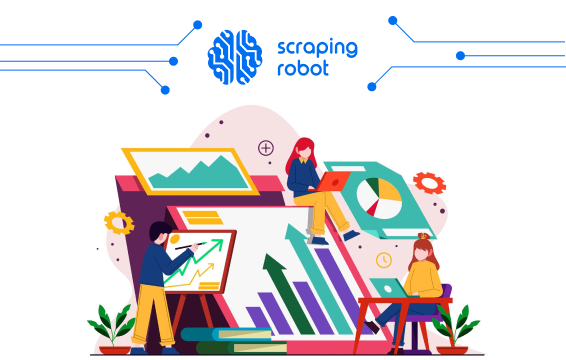Data-Driven Media Planning (With Web Scraping)

Finding success in your business means creating smart, cutting-edge content that makes lasting impacts on your audiences. We’ve all come to accept how much of an impact social media has on any organization. That means there is a lot of noise in any given market, all the time. There is no shortage of new content, and crafting a strategy to yell louder than the other brands means you must have insights and data to fuel your efforts.
Web scraping is the perfect tool to keep data consistently being fetched for you. In this blog, I will dive more into web scraping and its applications in media planning. Feel free to use the table of contents to skip to the information that is relevant to you.
Table of Contents
1. Media Planning and Web Scraping: Explained
2. How Web Scraping Benefits the Media Planning Process
Media Planning and Web Scraping: Explained

HubSpot defines media planning as “the process of determining how, when, where, and why your business will share media content with your target audience. The process includes deciding what media will be shared via different channels and platforms to boost reach, engagements, conversions, ROI, and more.”
Some things must be carefully considered before adding them to your media plan. But what is a media plan? It is a set schedule of content to be published on multiple social media channels. Things specified in this plan are what kind of post it is, what time you will post it, a short description of the content, and more.
Examples of things to be considered before posting on social media are what kind of content works best on each platform and your target audience’s demographics on different social media channels. Where are they spending the most time on social media? How do they want your brand’s content to fit into their social media feeds? Why did they decide to follow you? How does your brand appeal to them?
These are the sort of questions you must consider before implementing a media plan for your brand or organization. A double-tap on a photo sharing site takes seconds but delivering content that makes them want to engage with you and give you that virtual pat on the back is a whole other challenge. This is where data collection comes in, and web scrapers give you the best option to gather the data necessary to answer those tricky questions.
What is web scraping?
Generally speaking, web scraping is a method of extracting data from websites. Web scrapers can gather large amounts of data from you, process and parse through the data to find the most relevant information to you, and transfer it into a document for you. Typically, the type of document delivered is in an organized and categorized spreadsheet form for your ease of reading.
How Web Scraping Benefits the Media Planning Process

Here are some benefits as to how gathering data from web scrapers can benefit your media plans.
Staying relevant
With Scraping Robot, you can run a scrape every 60 seconds, meaning you are receiving data on the most current trends and topics people are talking about. By doing this manually, a large part of your day could spend scrolling through social media.
Web scraping automatically collects this data for you, saving time and delivering results in real-time, giving you a potential edge amongst everyone and everything else.
Increased engagement
By scraping data about your customers and trending topics, you can better understand what kind of content will stand out to them. These are not the only factors to strategic media planning, but they’re two considerable factors.
Developing leads
If you are a newer organization or looking to move into a new target demographic, developing leads with people on social media is a powerful way to get someone looking and thinking about purchasing your products or services.
Purchasing ad space (or media buying) on social media sites with the right demographics and message can bring you many new customers if done correctly.
Better SEO
If you’re new to SEO (search engine optimization), it is the process to which you create content for it to appear higher on search engine results. Most people do not make it past the first two search engines’ first pages, so planning content and media to cater to SEO guidelines.
There a few ways that web scrapers can boost your SEO. Determining what categories your content performs the best in, find influencers with blog comments, search organic keywords, find your content on forums to create backlinks, and more.
What Information You Need for Digital Media Planning

You need some key information to help build your strategy. Here are some data points you should scrape.
Market trends
There is a baseline need for understanding consumer needs and how you can fill them in any market. The tricky part is that once you know your market’s current climate, it has the potential to change. Keeping up with these changes and adjusting your planning strategy to reinforce your brand’s message can continually adapt to your needs is vital to stay relevant to your audience.
Web scraping key market research points allow you to anticipate and adjust your media plans to accommodate a potential PR disaster. For example, if there is a significant tragedy in your country and your scheduled post about new ways to style a piece of clothing goes up, it could make for a sour sentiment in your consumers’ minds. While this is an extreme case, the point remains!
Continuously scraping social media sites ensures that you always have the most relevant information as soon as it is established, leaving you with more response time.
Consumer feedback
The classic statement ‘the customer is king’ always remains true. Understanding how your consumers perceive your brands and products is more important than ever. We live in an age where we want to know much more about a brand than ever. Making sure that your values, voice, and messages are clear ensures that customers can back you. But, they also want to double-check other consumer reviews to make sure their gut instinct is right.
Luckily, most people care to share their sentiments about brands in similar places online, and that is popular review sites and social media spaces. Scraping Robot has modules to scrape consumer sentiment on such sites.
This way, consistently scraping allows you to monitor sentiment and fix any potential problems before they blow out of proportion. Or, share great feedback to boost your social media with positive reviews.
Targeted branding and promotions
Pursuing data to understand when and where your target audience is most active is very valuable. That way, your users see your posts rather than getting lost in complicated social media feed algorithms. With any brand, you have different groups of target consumers, and they spend time in various online spaces.
But, where does web scraping come in? By scraping your followers’ profiles on different social media channels, you can gain a greater understanding of who your audience is and what kind of things they want to see. Pairing this with the data of when they are more active, your chances of engagement are much higher.
An example of this in use is with Spotify. Spotify boasts one of the largest music libraries of any streaming service, so choosing something to listen to can be tedious and overwhelming at times. But how did they combat this? With targeted playlists.
Spotify is consistently updating and publishing ‘themed’ playlists and created a whole catalog of them for you to get use of. But, on the home page, your recommendations are changed throughout the day. In the morning, they may advertise more pumped up music to get you excited for the day. In the afternoon, they may recommend a ‘coffee house’ playlist with soft melodies to help keep you focused on working. In the evening, it could be soft low-melody songs to help you to sleep. Tailored recommendations mean more use of their service.
Competitive monitoring
Knowing less than your competitors is never a good look. That is why you need to learn what they know, then learn even more. Monitoring the competition’s social media strategy and learning from your mistakes is a crucial way to step above the noise in your market.
Scraping data from your competitors can mean digesting many data, but it’s crucial to understand their strategy, so you’re not repeating the same messages as them. Repeating messages leads you to the danger of being labeled unoriginal or dated.
The beauty of gathering competitor data is that you can utilize the same web scraping tools to collect data for your organization. You may have to gather more data because you should already understand your social strategies and, depending on the size of the business, more of their consumer sentiments to analyze.
Using Scraping Robot as Your Media Planning Tool

With an initial offer of 5000 free scrapes per month, you can play around with our web scrapers to become comfortable with our website and a web scraping pro. When you run out of the free scrapes, our pricing page gives you the means to play around with how many scrapes can fit into your budget. With each additional scrape costing only a fraction of a penny ($0.0009 per scrape), you’ll be surprised with how affordable our service is. There are no hidden subscription or added fees. What you see is what you pay!
Final Thoughts
Juggling data collection to successfully execute a media planning strategy is essential, or else you can easily drown in the processes. Scraping Robot is the tool you need to let the stress of data collection go and spend more time coming up with great content ideas!
The information contained within this article, including information posted by official staff, guest-submitted material, message board postings, or other third-party material is presented solely for the purposes of education and furtherance of the knowledge of the reader. All trademarks used in this publication are hereby acknowledged as the property of their respective owners.
